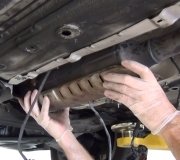You're suffering from all kinds of misinformation. First, when the catalytic converter is plugged, the exhaust gas can't get pushed through it by the engine, which is essentially an air pump. You'll have very low power, a low maximum vehicle speed, and the engine will idle uncommonly smoothly with a steady hiss from the tail pipe instead of the normal "putt putt".
A red hot catalytic converter is caused by too much unburned fuel going into the exhaust, most commonly due to a spark-related misfire. That would not agree with my previous guess of a plugged pickup screen.
The fuel pump can be replaced two ways. If you get a Chrysler original, or the same part from an auto parts store, you'll get the entire drop-in assembly that includes that pickup screen. The other way is to get just the pump and motor that has to be transplanted into the housing assembly. That takes more time but the parts cost less. Some of those come with a new screen that you're instructed to replace. Others just tell you to buy a new screen and replace it.
For future reference, other than on diesel vehicles, you will almost never solve a running problem on a Chrysler product by replacing the fuel filter. Put that way on the bottom of your list of suspects.
It is extremely doubtful your running problem is caused by the Engine Computer, and your mechanic is wrong; it is not in the distributor as in some import cars. Your Engine Computer is mounted to the left inner fender right beside the battery. There's a fresh air tube hooked to the back of it that sends air to the throttle body assembly and intake manifold. It also has a 60-pin connector with three rows of terminals, and possibly another connector with a dozen or so larger terminals. On your engine, the computer is triggered by the Hall Effect switch assembly under the rotor in the distributor. That IS a pretty high-failure item. Chrysler had extremely little trouble with their Engine Computers, so put that way down on the list of suspects too.
The computer drives a single ignition coil with spark routed to the correct cylinder by the distributor.
So, ... The red hot catalytic converter told us fuel isn't being ignited or there's too much of it going into the engine. A failed computer or ignition coil will cause total stalling since all four cylinders would no longer receive spark. If the Hall Effect switch fails, the computer would turn off the automatic shutdown relay which would turn off the ignition coil, injector, alternator field, and fuel pump. With no injector pulses the catalytic converter would not get red hot and you wouldn't smell unburned gas.
That leaves us with something that can start to fail by causing just a few random cylinders to misfire, then, when it gets worse, presumably with more engine heat, it causes them to totally not fire and the engine stalls. That is one potential way for an ignition coil to fail internally. There are three systems that need to be looked at for this problem. The fuel supply system, other than that pickup screen, will cause about one percent of stalling problems. The ignition system, in this case meaning the ignition coil, will cause perhaps four percent. The other 95 percent are caused by what both systems are triggered by, which is that Hall Effect pickup coil in the distributor.
The place to start is by monitoring the ASD relay when the stalling occurs. The easiest way to do that is to connect a grounded test light to either of the smaller terminals on the back of the alternator. You will see 12 volts there for one second when you turn on the ignition switch. Then it will go to 0 volts. The 12 volts will come back during engine rotation, (cranking or running). What we need to know is if there's still 12 volts there when the engine stalls and you're trying to restart it. If there is 12 volts during cranking, you'll have to determine if you're missing spark OR fuel pressure. If there is not 12 volts during cranking, you will not have spark AND injector pulses and it's the distributor we have to look at. Don't be fooled by the fuel pressure. The pump will also be dead but there will be residual pressure at the throttle body from those initial one-second bursts when you turned on the ignition switch.
If you still have spark and the ASD relay is turning on, it suggests you're getting too much fuel. Watch the cone-shaped fuel spray in the throttle body. That should look like a real thin sheet of rough ice. If you see droplets or a small stream of fuel, suspect the MAP sensor. That has the biggest say in fuel metering calculations and can cause too much fuel to enter the engine. Other sensors just modify those calculation slightly so don't waste your time with those. Also check the vacuum hose going to the MAP sensor for leaks and cracks, and check the other vacuum hoses for leaks. A leak will lower intake manifold vacuum which equates to acceleration and the need for more fuel. Even if you had a scanner to view live sensor data, the change in MAP voltage is too small for us to interpret between right and wrong when it causes a big decrease in engine performance. Unless the signal voltage is obviously wrong, we either have to go by a diagnostic fault code, or, ... I really hate to say this, ... We have to plug in a new one to see if it solves the problem. We never like throwing random parts at a problem.
Thursday, July 23rd, 2015 AT 8:15 PM


